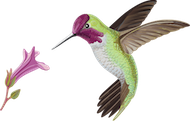As the Gottlieb Native Garden’s naturalist, Scott Logan documents the ever-changing array of wildlife species as they vary with the garden’s blooms, seasons and migratory patterns. While bringing these observations to life for all to experience, he also coordinates scientific research projects, and monitors the overall health and biodiversity of the garden. The Naturalist’s Journal also highlights the work the Gottliebs and Scott are doing to educate and inspire people to start gardening for wildlife with native plants.
Jumping Spider
An agile hunter prowls the GNG – the jumping spider. With their exceptional vision and pinpoint jumping ability, this family of spiders is extremely successful, being represented by almost 5000 species! They will both lay in wait and stalk prey with the capability to take […]
Wasps are Capable Hunters
Animal species that hunt in the GNG come in many shapes and sizes. Yellow Jackets are one of these hunters and have the ability to capture fast moving insects like this Green Bottle Fly. The wasp will not be dining on the fly though (adults […]
Green Lynx Spider
Fittingly named for their bright green body and capability of running, then jumping on prey, the Green Lynx Spider can be one of the more aggressive hunters in the GNG. Their fierce looks and size can be intimating to an observer and females have the […]
Nectar Time!
This 30-second video compresses 5 minutes of hummingbirds enjoying their mid-morning nectar. Allen’s Hummingbirds, Anna’s Hummingbirds and Black-chinned Hummingbirds are all represented, along with a quick visit from a female Hooded Oriole. It is simply untrue that giving sugar water to hummingbirds is harmful to […]
Native Pollinators
One goal of the GNG is to create a healthy habitat for pollinators, especially native bees. California has over 1,600 species of native bees that come in many different sizes and adornments. One of the most common bee families in the world is the small […]
A Mule Deer’s New Antlers
This buck’s antlers are now just-fully grown and beginning to harden. We know this because in the last frames of the video you can see a strip of hanging velvet. As deer antlers harden and the velvet dries up, bucks will begin to rub them […]
Orange-crowned Warbler
Fall warbler migration is just upon us and Orange-crowned Warblers are leading the charge! A few orange-crowns have been seen recently in the GNG and we expect visits from many other warbler species as summer moves into fall.
Deception in the Garden
A carful walk in GNG may reveal an amazing form of survival. Many species of animals employ a wide variety of camouflage tactics, and one of these tricks is called background matching. Background matching is commonly used as camouflage, allowing an animal to blend […]
Orioles Have Started to Move South
This could be our last adult male Hooded Oriole camera capture for 2015 as their southward migration has begun. Females and juveniles should follow the adult males in a few weeks..
Vivid Dancer Damselflies
The Vivid Dancer is probably the most common damselfly in the Santa Monica Mountains, and at the moment they are abundant in the GNG. Even though they will ultimately lay their eggs in the upper pond (the lower pond does not have the ecosystem to […]

